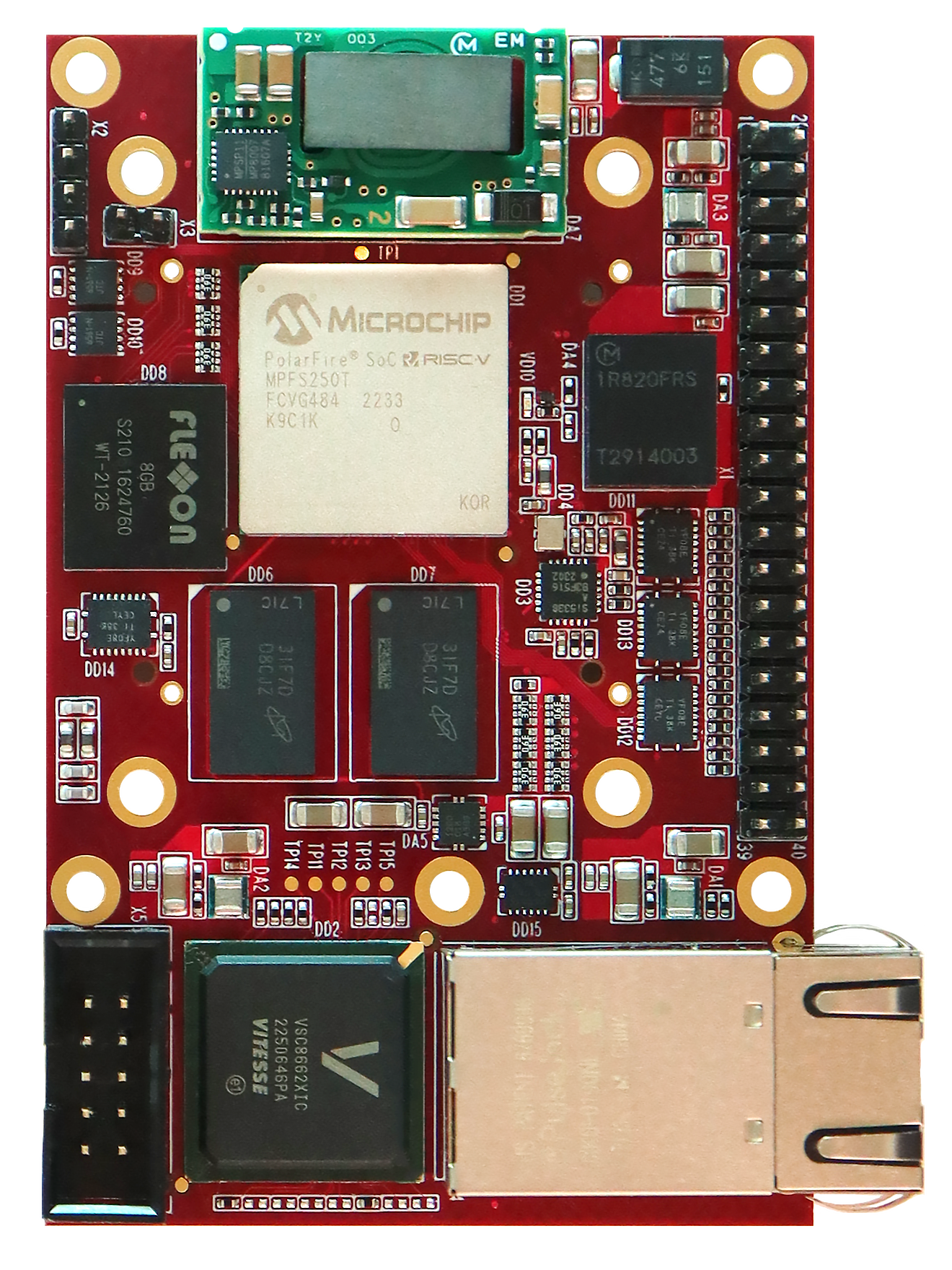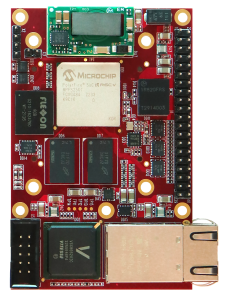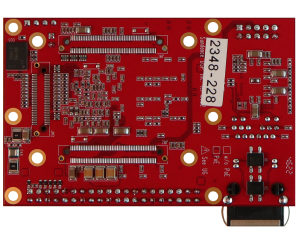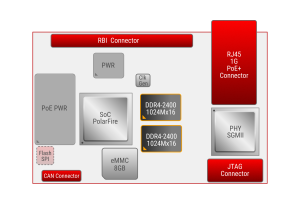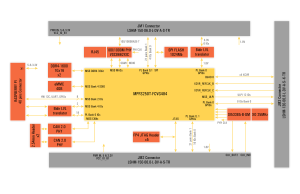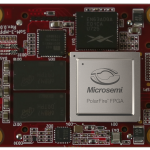PolarBerry is the first production and deployment-ready SoM with a hardened 64-bit, multicore real-time, Linux-capable RISC-V MPU subsystem to deliver an unparalleled combination of defense-grade security, low power consumption, and thermal efficiency for embedded systems development. In the new version, it is now PoE enabled by request!
- Based on Microchip’s PolarFire® SoC FPGAs, combining FPGA capabilities with a 64-bit, Linux-capable multicore RISC-V processor
- Delivers an unparalleled combination of defense-grade security, low power consumption, and thermal efficiency for smart, connected systems
- Ideally suited to defense/mil-aero, AI/ML, communications, automotive, industrial automation, and imaging applications, as well as the Internet of Things
With Microchip’s PolarFire SoC FPGA at its heart, providing a deterministic, coherent 64-bit RISC-V CPU cluster and a deterministic L2 memory subsystem enabling the implementation of secure Linux and real-time applications, PolarBerry is ideally suited to the development of embedded computing and real-time applications based on RISC-V processors as an alternative to ARM. Typical applications will be found in the defense/mil-aero, AI/ML, communications, automotive, industrial automation, and imaging markets, as well as the Internet of Things.
PolarBerry’s compute engine delivers up to 50% lower power than alternative FPGAs and 250k logic elements (LEs) and features four high-speed, low-power transceivers from 250Mbps to 12.7Gbps. The PolarFire SoC FPGA’s maximum power consumption is 12W, and power is provided directly from the PolarBerry SoM to enable embedded solutions.
The PolarBerry SoM offers all the important attributes for strong SoC/FPGA design security, including anti-cloning protection, device-level anti-tamper features, bitstream protection, key management, FPGA hardware access control, secure boot, and physical memory protection (PMP), as well as supply chain assurance. It also features a 40-pin Raspberry Pi (RPI) interface to allow standalone operation and rapid application development by providing up to 26 GPIOs, 20 of which can be assigned to SPI, UART, CAN, or other interfaces. All RPI signals are 3.3V logic. Associated onboard PolarBerry SoM peripherals include 4GB of 32-bit wide DDR4 memory, 128MB SPI Serial NOR FLASH for storing the boot image, and programmable clocks to provide flexible clocking to the FPGA and high-speed transceivers. There is also an RJ45 Ethernet socket with 100/1000Base-T interface, two CAN 2.0 physical layers, a JTAG interface for programming, and 4GB of eMMC non-volatile storage. Samtec connectors provide high-speed communication to a carrier board for powerful peripheral customization. The power consumption of the module is 16W, with the power can be applied via the PRI interface or the carrier board.
The PolarBerry SoM measures just 55mm by 85mm and has an operational temperature range of 0°C to +70°C. It can also be installed on Sundance’s PCIe SoM carrier to provide access to an FMC and additional interfaces.
Our new revision of the Polarberry SOM features a new ordering option of Power over Ethernet! This feature will allow the already popular Polarberry to be used in a larger range of embedded applications such as IP cameras, IP TV decoders, Industrial Control Systems, and point-to-point Microwave systems. Additionally, PoE will facilitate the use of Polarberry as a stand-alone development platform for projects using both custom firmware and software in a familiar form factor.
All Polarberry PoE boards are pin compatible with the Polarberry SOM and can be assembled to be carrier powered if required. All Polarberry’s purchased will have the PoE hardware installed by default but can be modified depending on customer requirements. Please check the ordering options tab for more information.
Features
- PolarFire SOC FPGA from Microchip (MPFS250T-FCVG484).
- 4 GB of 32-bit wide DDR4 memory (MT40A1G16WBU-083E: B DDR4)
- 128MB SPI Serial NOR FLASH for storing boot image.
- Programmable clocks using – SI5338A – provide flexible clocking to FPGA and High-Speed transceivers.
- 4 High-speed low-power Transceivers from 250Mbps – 12.7Gbps.
- IOs via high-speed Samtec connectors.
- Raspberry PI interface connector (RPI) with 40 pins, contains the following:
- 1 x I2C from MSS part;
- 1 x UART from MSS part.
- 20 x GPIOs from PL part(can be assigned to SPI, UART, CAN, or another interface from MSS).
- 6 x GPIOs from MS’s part.
- All RPI signals are 3.3V logic.
- The module contains 4 GByte of eMMC storage for various purposes.
- The module contains 2 X CAN 2.0 PHY. CAN bus routed to PH1-04-UA pins header.
- JTAG routed to high-speed Samtec connector.
- SPI interface from FPGA routed to high-speed Samtec connector.
- One 100/1000BASE-T interface routed to the IO connector.
- One RJ-45 connector with 100/1000BASE-T interface.
- Bank 1 IOs from FPGA, including ULPI, are routed to high-speed Samtec connectors.
- Onboard power for MPSoC.
- Built-in FPGA internal oscillator for configuration and other purposes.
- Onboard XO 25MHz ±10ppm stability over temperature, as a reference.
- Mechanical dimensions are 55 x 85 mm.
- Power IN 5V and 3.3V.
- Power consumption is 12 Watts maximum.
- The power consumption of the module is 16 W.
- The temperature range is 0°C to +100°C.
Applications
- Automotive
- Defense
- Imaging
- Automation
A project including software, firmware and driver will be provided for testing the board.
PB-MPFS250T-FCVG484E-XXX-YYYY
PB-MPFS250T-FCVG484I-XXX-YYYY
XXX – Can be PoE if PoE powered option is needed or CP if carrier powered (also can be powered via RPI) is necessary
YYYY – Can be LSHM if the LSHM SoM connectors need to be installed, leave blank if no SoM connectors need to be installed

